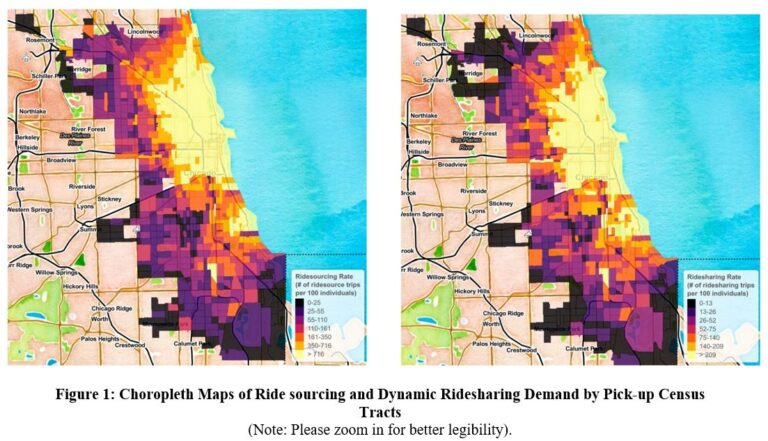Spatiotemporal Ride-Hailing & Ridesharing Demand

Promoting sustainable transportation, ride-sourcing and dynamic ridesharing (DRS) services have transformative impacts on mobility, congestion, and emissions. As emerging mobility options, the demand for ride-sourcing and DRS services has rarely been simultaneously examined. This study contributes by jointly analyzing the demand for ride-sourcing and DRS services and examining how it varies across neighborhood-built environment, transit accessibility and crime, behavioral, and sociodemographic factors.
To achieve the objectives, unique geo-coded data containing millions of ride-sourcing and DRS trips in Chicago are spatially joined with up-to-date data on built environment, transit accessibility, crime, active travel and demographic factors. A novel and comprehensive geo-additive Markov Random Field based joint heterogeneous copula framework is presented to simultaneously capture random, systematic, and spatial heterogeneity. Characterized by a Frank copula structure, the demand for ride-sourcing and DRS services exhibited a non-linear stochastic dependence pattern. With spatial heterogeneity and spillover effects, ride-sourcing and DRS demand was higher in more compact neighborhoods.
Key aspects of the built environment related to urban design (pedestrian-oriented infrastructure), density, and land-use diversity were positively correlated with ride-sourcing and DRS demand – suggesting that sustainable mobility goals can be achieved by continuing to invest in compact and more walkable neighborhoods. Active travel and telecommuting were positively linked with ride-sourcing and DRS demand. Complementary and substitutive effects for transit accessibility were found. Results show that increasing transit accessibility in areas with low levels of accessibility (compared to those with high transit levels) could be more helpful in increasing adoption of ride-sourcing and DRS services. Quantification of non-linear associations with ceiling and overdose effects for built environment, vehicle ownership, and transit accessibility provided deeper insights. The findings can help guide development of policy interventions and investment decisions to further accelerate adoption of mobility on-demand systems.

The above choropleth map illustrates the spatial distribution of the two endogenous response outcomes: ride-sourcing and dynamic ridesharing demand – revealing spatial heterogeneity in ride-sourcing and DRS rates across the census-tracts in Chicago. The demand for ride-sourcing and DRS services is highest in the downtown Chicago area which is unsurprising since central business districts (CBD) exhibit larger attractions and greater activity.
Figure 2 below provides further insights based on the underlying origin-destination matrix calculating the total number of all trips, ride-sourcing, and ridesharing trips between each pair of origin-destination census tracts (leading to a total of 200956 flows / O-D pairs). A semi-monocentric pattern of the city with most flows ending around downtown.

Publications:
Wali, B., Santi, P., Ratti, C. (2021). Jointly Analyzing Ride-sourcing and Dynamic Ridesharing Demand: A Geo-Additive Markov Random Field Based Heterogeneous Copula Framework. (Under-review).
Wali, B. (2021). Modeling Consumers’ Use of of Carsharing and Ridesharing Services – An Integrated Finite Mixture Copula-Based Behavioral Choice Framework. (Under-review).
Major Contributors:
Paolo Santi, Ph.D., Principal Research Scientist, MIT Senseable City Lab.
Carlo Ratti, Ph.D., Professor & Director, MIT Senseable City Lab.
Acknowledgement:
We would like to thank AMS Institute, Allianz, Anas S.p.A., Austrian Institute of Technology, Brose, Cisco, Dover Corporation, Ford, Fraunhofer Institute, KTH Royal Institute of Technology, Kuwait-MIT Center for Natural Resources, Lab Campus, Politecnico di Torino, RATP, SMART—Singapore-MIT Alliance for Research and Technology, SNCF Gares & Connexions, Teck, UBER, UTEC – Universidad de Ingeniería y Tecnología and all the members of the MIT Senseable City Lab Consortium for supporting this research.